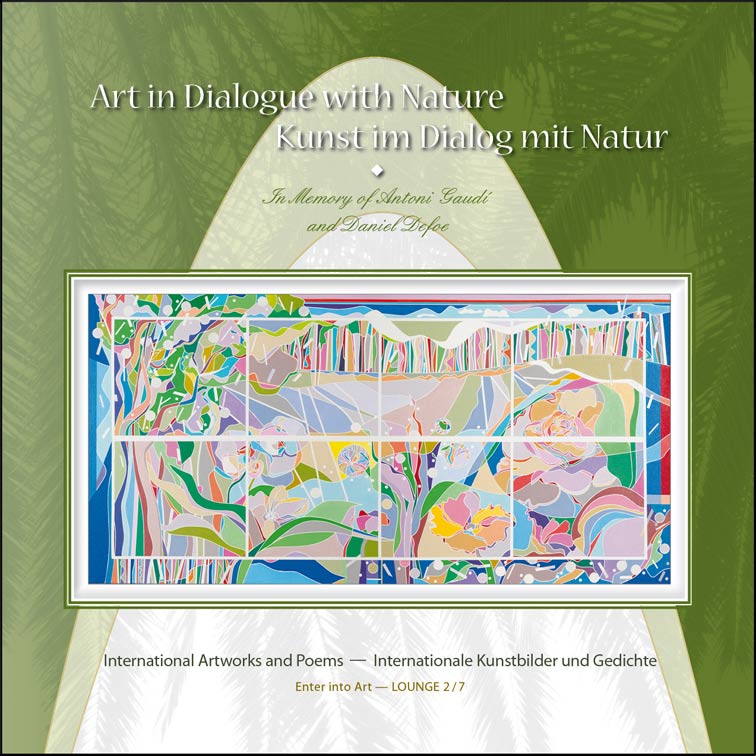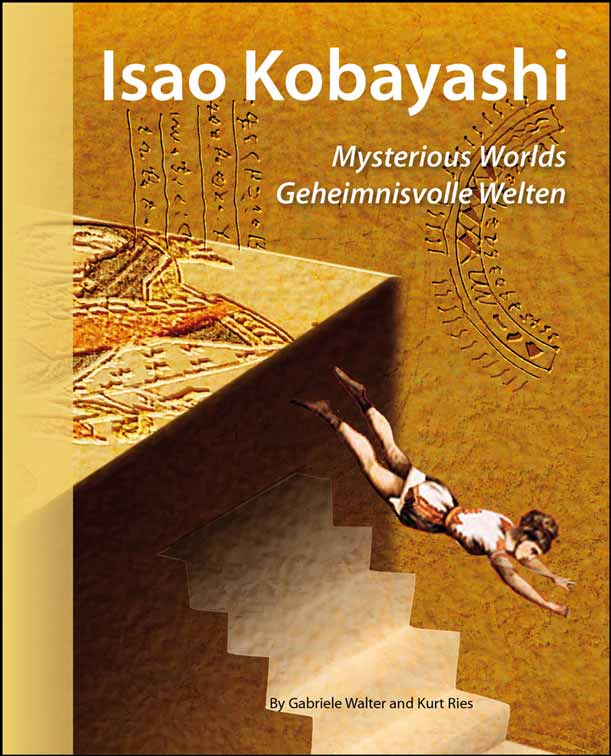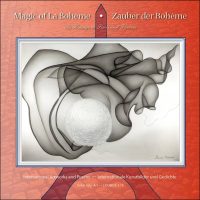A tradition and also a unique selling point of the “Enter into Art” book series is the blend of art, poetry and music.
Gift idea:
There is a suitable music suggestion in almost all of our books. Perhaps a CD together with the book will be a very special surprise for art lovers. A foreword in the book informs the reader in an entertaining way about the book topic and also about the pieces of music. In this way you can listen to music while looking at the works of art or reading poetry. Of course, you can also make music yourself in your “refuge of the muse”.
But the whole world understands my language.
Joseph Haydn
Relax with art, poetry, music and sound
“The color does something.”
Johann Wolfgang von Goethe
Music and art as well as poetry and sound are both a gateway to the self and a bridge to the cosmos. The artistic journey to relaxation and pleasure not only comes through the careful observation of art images, but also through the path of poetry, sculpture and sound. The music is further relaxing and resembles the scent of flowers floating in the air.
Researchers have found that colors have a higher vibrational energy than sounds – so they are even more effective than the spoken word. In contrast, the pieces of music from the classical repertoire that are matched to each color or theme of our books are musical recommendations that correspond to a tone color. They too carry you away into worlds of the imagination. The gentle flow of the melody addresses the emotional side of the brain and increases concentration so that it is easier to indulge in the enjoyable viewing of the images.
Color is understood and loved equally by people of all nations because it represents that mysterious medium which really connects people across all borders and in the depths of their psyche. With the help of colors, physical and mental well-being can then be influenced.
Poetry is also sound, with the music of the vowels and consonants playing an important role. Poetry can provide musical pleasure in that it can be perceived as music in addition to the meaning (content). In this sense, music also differentiates itself from painting, whereby abstract, non-representational painting (especially because of its color tones) is closer to music than representational art or prose.

Johann Sebastian Bach
- The Art of the Fugue – Die Kunst der Fuge
- Music played a major part in the teachings of the Bauhaus Academy. Paul Klee saw colors, shapes and lines as musical phenomena. In his painting “Fugue in Red” he visually applied Bach’s principle of composing fugues.

At “Chiesa San Vidal”, Vivaldi concerts take place.
- Claudio Monteverdi “L’incoronazione di Poppea” (opera premièred during carnival season 1642 – 1643)
- Johann Strauss “A Night in Venice” (operetta in three acts)

“Sansoucci” – A Taste of Art, Music and Wine
This was the time when Frederick the Great began exchanging letters with Voltaire. Bach also performed at the Court in Berlin.
- Johann Sebastian Bach, „Brandenburg Concertos“ (six concertos for table music)

The libretto of this opera was loosely based on the novel “Scènes de la Vie de Bohème” by Henri Murger:
- Giacomo Puccini, „La Bohème“ (Opera in Four Acts)

Like Vincent van Gogh, Paul Gauguin loved the music of colors, which he compared to that of Beethoven:
- Georges Bizet: L’Arlésienne Suite No. 1 & Suite No. 2
- Ludwig van Beethoven: „Ode to Joy“, Finale from Symphony No. 9
Dreams of Color – The Gold of the Sun as a Symbol of Enlightened Beauty

In addition to the works of art and art interpretations the editor introduces famous musical works which may contribute to the harmonious overall sound of the book and hopes to inspire readers to expand their perception to the tonal aspects of art and poetry:
- Felix Mendelssohn, Robert Schumann, Johannes Brahms, Edward Elgar, Claude Debussy

Conversing with Nature
- “Robinson Crusoe” by Jacques Offenbach
- „Gaudi“ by Eric Woolfson
- “The Song of Birds” – El cant dels ocells” (Catalan folk and Christmas song) by Pablo Casals

Légende Nr. 1 St François d’Assise and Cantico del sol di San Francesco d’Assisi can be considered Liszt’s musical monuments to his patron saint – and German namesake – Franz von Assisi (St. Francis of Assisi).
- “La prédication aux oiseaux” by Franz Liszt
- „Le Carnaval des animaux“ by Camille Saint-Saëns

In the famous “Song of the Fates” in Act IV of Johann Wolfgang von Goethe’s play “Iphigenia in Tauris”, Iphigenia questions the morality of human sacrifice.
- “Song of the Fates, Op. 89” by Johannes Brahms
- “La Belle Hélène” by Jacques Offenbach
- “Il ritorno d’Ulisse in patria” by Claudio Monteverdi
- “Sirènes, Trois Nocturnes No. III” by Claude Debussy
A Modern Odysseus on the Trail of Homer’s Epics / Iphigenia as a Symbol of Peace

Not only the “Magic Flute” shows the fairy tale like orientalism of Mozart’s work.
- “A Little Night Music”
- “Violin concerto no. 5 in A major, KV 219”
- “Piano sonata in A major, KV 331”
- “Abduction from the Seraglio”

Claude Debussy took up the painter’s ideas in his compositions. Like Monet, the composer made different color shades blend into each other at the threshold of modernity:
- “Reflets dans l’eau“ (“Reflections in the Water”)
- “La mer” (“The Sea”)
- „La cathédrale engloutie“

George Sand and Frédéric Chopin on the Isle of Majorca
The editor of the book has assigned a selection of Chopin’s Mallorca Preludes op. 28 to the colors, both according to their key and according to their musical statement.
- CD “Chopin en Mallorca, Piano Ireneusz Jagla”

The title of the book speaks for itself! You can find more information in the foreword of the book:
On Ludwig van Beethoven’s „Moonlight Sonata“ (Sonata in the Manner of a Fantasy)
- “Moonlight Sonata” by Ludwig van Beethoven

In addition to the works of art and art interpretations the editor introduces one famous musical work that may contribute to the harmonious overall sound of the book and hopes to inspire readers to expand their perception to the tonal aspects of art and poetry:
- “The Seasons” by Joseph Haydn

The chapter “Music Suggestion” in the solo book suggests the following koto piece:
- “Akikaze no Kyoko” by Mitsuzaki Kengyô (Melody of the Autumn Wind)
You can find more information in the book!

Guillaume Apollinaire’s words set to music and his time in the Rhineland
- “Le Pont Mirabeau” by Léo Ferré
- “Six Poèmes d’Apollinaire” by Arthur Honegger
- “Sinfonie Nr. 14 opus 135” by Dimitri Schostakowitsch
- “La Chanson du Mal-Aimé” by Renier van der Velden

At the beginning of each color chapter in the book the title of a poem by Johann Wolfgang von Goethe is mentioned, which Ludwig van Beethoven had set to music. In particular, the following songs are very famous:
- “Do you know the country?”
- “Flea Song of Mephisto”
Also in the “Kunstretreat” books 2016 and 2017, a well-known piece of classical music is named in each color chapter, so that the tonal sound of color (art images) and music can be combined.
BUY BOOKS – LEAF THROUGH OUR BOOKS
Perhaps you are interested in our playlists on YouTube that match the classic topics of our books?










